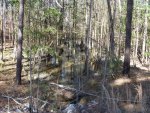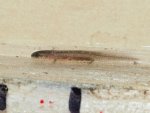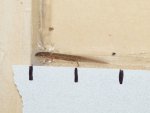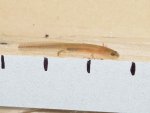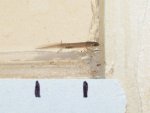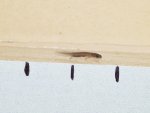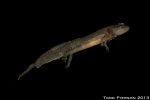-
Did you know that registered users see fewer ads? Register today!
You are using an out of date browser. It may not display this or other websites correctly.
You should upgrade or use an alternative browser.
You should upgrade or use an alternative browser.
Larval Hemidactylium scutatum
- Thread starter Lamb
- Start date
Lamb
New member
- Joined
- Feb 28, 2009
- Messages
- 222
- Reaction score
- 12
- Points
- 0
- Age
- 37
- Location
- USA
- Country
- United States
This must be my lucky month. I found 4 more larval Hemidactylium scutatum at a different stream earlier today. One of these was incredibly small, and I'm assuming a recent hatchling (the one labeled TC5). The black lines in the lateral shots represent centimeters.
Attachments
Lamb
New member
- Joined
- Feb 28, 2009
- Messages
- 222
- Reaction score
- 12
- Points
- 0
- Age
- 37
- Location
- USA
- Country
- United States
After lots of photo exchanges with others that have had more experience with tiny, larval E. quadridigitata and H. scutatum, I regret to say that all of the larvae in these photos are likely the former (dwarf salamanders), and not the latter (four toed salamanders).
Kaysie
Site Contributor
- Joined
- Mar 10, 2003
- Messages
- 14,463
- Reaction score
- 112
- Points
- 0
- Location
- North Dakota
- Country
- United States
- Display Name
- Kaysie
What a bummer!
Neotenic_Jaymes
Active member
Small larvae are always hard to ID.
pierson_hill
New member
- Joined
- May 7, 2007
- Messages
- 24
- Reaction score
- 7
- Points
- 3
- Age
- 43
- Location
- Tallahassee, FL
- Country
- United States
- Display Name
- Pierson Hill
My vote is for Hemidactylium. Here's one I hatched from an egg:

Four-toed Salamander (Hemidactylium scutatum) by Pierson Hill, on Flickr
Here is a Eurycea quadridigitata larvae. Note the striations, elongate build, and lack of dorsal light spots.

Eurycea quadridigitata by Pierson Hill, on Flickr

Four-toed Salamander (Hemidactylium scutatum) by Pierson Hill, on Flickr
Here is a Eurycea quadridigitata larvae. Note the striations, elongate build, and lack of dorsal light spots.

Eurycea quadridigitata by Pierson Hill, on Flickr
Lamb
New member
- Joined
- Feb 28, 2009
- Messages
- 222
- Reaction score
- 12
- Points
- 0
- Age
- 37
- Location
- USA
- Country
- United States
I've got two in the lab that I'll raise through metamorphosis, photographing them along the way. I'll let you know what they turn out to be.
@Pierson - From what I have seen in S MS, dwarf salamander larvae can be really variable. I have found larger larval dwarf salamanders that have similar striations to the one in your photo, but I have also found them in this part of the region without striations. As for the dorsolateral spots in the larvae in my photos, they appear to be different from the spots on larval four-toed salamanders. It seems like the spots on four-toeds are a bit larger, much more dorsal with little space between the rows, and they often have some sort of color (yellow or chestnut). Larval Eurycea cirrigera and sometimes Eurycea guttolienata have similarly spaced, small light spots, which, from what I understand, are aggregations of iridophores around the lateral line organs. So I don't think that it's unlikely that small, larval dwarf salamanders might also have dorsolateral spots. It's also worth pointing out that what we call Eurycea quadridigitata is likely a species complex, so that might explain some of the regional differences in larvae.
Another key feature that appears to hold for H. scutatum is that the dorsal fin origin is anterior to or at least at the midbody point, whereas for E. quadridigitata, it is not.
@Pierson - From what I have seen in S MS, dwarf salamander larvae can be really variable. I have found larger larval dwarf salamanders that have similar striations to the one in your photo, but I have also found them in this part of the region without striations. As for the dorsolateral spots in the larvae in my photos, they appear to be different from the spots on larval four-toed salamanders. It seems like the spots on four-toeds are a bit larger, much more dorsal with little space between the rows, and they often have some sort of color (yellow or chestnut). Larval Eurycea cirrigera and sometimes Eurycea guttolienata have similarly spaced, small light spots, which, from what I understand, are aggregations of iridophores around the lateral line organs. So I don't think that it's unlikely that small, larval dwarf salamanders might also have dorsolateral spots. It's also worth pointing out that what we call Eurycea quadridigitata is likely a species complex, so that might explain some of the regional differences in larvae.
Another key feature that appears to hold for H. scutatum is that the dorsal fin origin is anterior to or at least at the midbody point, whereas for E. quadridigitata, it is not.
taherman
Caudata.org Donor
- Joined
- Aug 24, 2007
- Messages
- 405
- Reaction score
- 62
- Points
- 28
- Location
- Whitehouse, OH
- Country
- United States
Pierson...where did your Hemidactylium larva originate? We are trying to get a handle on geographic variation in the larvae, and all my examples to compare to are from more northern populations. Yours still has all the traits of my northern Hemidactylium larvae that we have used to discern the two.
Also, the E. quad larva you posted is much later in development than Lamb's. It's these really early larvae that are giving us trouble with ID.
Thanks for the photos!
Also, the E. quad larva you posted is much later in development than Lamb's. It's these really early larvae that are giving us trouble with ID.
Thanks for the photos!
pierson_hill
New member
- Joined
- May 7, 2007
- Messages
- 24
- Reaction score
- 7
- Points
- 3
- Age
- 43
- Location
- Tallahassee, FL
- Country
- United States
- Display Name
- Pierson Hill
Pierson...where did your Hemidactylium larva originate? We are trying to get a handle on geographic variation in the larvae, and all my examples to compare to are from more northern populations. Yours still has all the traits of my northern Hemidactylium larvae that we have used to discern the two.
Northern Florida. I can try and get you some larvae locally but we had a massive flooding rain event about a month ago that may have washed away most of the eggs (I lost the nest in my back yard).
Also, the E. quad larva you posted is much later in development than Lamb's. It's these really early larvae that are giving us trouble with ID.
True. I've seen quad larvae at much smaller sizes and they were all distinctly striated, but the vast majority were from mesic flatwoods ponds in the eastern FL panhandle.
Lamb
New member
- Joined
- Feb 28, 2009
- Messages
- 222
- Reaction score
- 12
- Points
- 0
- Age
- 37
- Location
- USA
- Country
- United States
Northern Florida. I can try and get you some larvae locally but we had a massive flooding rain event about a month ago that may have washed away most of the eggs (I lost the nest in my back yard).
I'm jealous that you found a nest in your backyard! Have you found E. quad and H. scutatum in the same sites?
Also, were your shots taken indoors, or in a tank you carry around in the field for just that purpose? The shot of the E. quad is really nice.
Todd Pierson
New member
- Joined
- Jul 31, 2009
- Messages
- 26
- Reaction score
- 6
- Points
- 3
- Country
- United States
FWIW, attached is a photograph of a (dead--had a rough time in the dipent) Eurycea quadridigitata larva from this past weekend. It was about 17mm SVL, had the horizontal striations, and lacked any light dorsal spots.
Also, Hemidactylium are still on eggs in the Piedmont of Georgia right now, but the nest I saw should be hatching any day. Hopefully I'll have some larval photographs of those to contribute soon.
Also, Hemidactylium are still on eggs in the Piedmont of Georgia right now, but the nest I saw should be hatching any day. Hopefully I'll have some larval photographs of those to contribute soon.
Attachments
Todd Pierson
New member
- Joined
- Jul 31, 2009
- Messages
- 26
- Reaction score
- 6
- Points
- 3
- Country
- United States
And here's a hatchling Hemidactylium from central Georgia, just a few hours out of the egg.


Todd Pierson
New member
- Joined
- Jul 31, 2009
- Messages
- 26
- Reaction score
- 6
- Points
- 3
- Country
- United States
I shoot top-down into a shallow aquarium suspended several feet above a black background, but I still black out most of the background in post-processing
DavidHarr
New member
- Joined
- Apr 8, 2014
- Messages
- 10
- Reaction score
- 0
- Points
- 0
- Location
- Portland, Oregon
- Country
- United States
- Display Name
- David B. Harrington
Please get in touch with me when you have a chance regarding a question about Hemidactylum larvae. You can e-mail me direct at: david7945harr@yahoo.com
Thanks,
David Harrington
Thanks,
David Harrington
General chit-chat
- No one is chatting at the moment.

